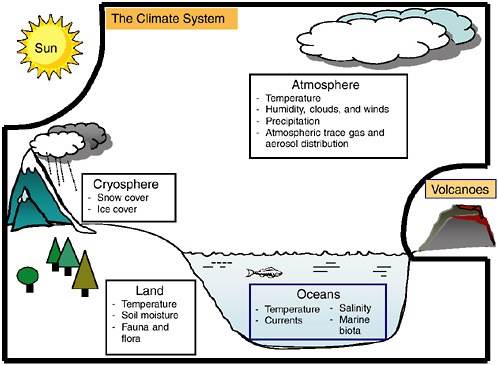Phillip Gentry has provided us with the September 2012 lower tropospheric temperature anomaly analysis from the University of Alabama at Huntsville. It is presented below [click each image for a clearer view]. Note the large spatial variations in the temperature anomalies.
Global Temperature Report: August 2012
Changing satellites as instruments die
Global climate trend since Nov. 16, 1978: +0.14 C per decade
September temperatures (preliminary)
Global composite temp.: +0.34 C (about 0.61 degrees Fahrenheit) above 30-year average for September.
Northern Hemisphere: +0.35 C (about 0.63 degrees Fahrenheit) above 30-year average for September.
Southern Hemisphere: +0.33 C (about 0.59 degrees Fahrenheit) above 30-year average for September.
Tropics: +0.15 C (about 0.22 degrees Fahrenheit) above 30-year average for September.
August temperatures (revised):
Global Composite: +0.21 C above 30-year average
Northern Hemisphere: +0.21 C above 30-year average
Southern Hemisphere: +0.20 C above 30-year average
Tropics: +0.06 C above 30-year average
(All temperature anomalies are based on a 30-year average (1981-2010) for the month reported.)
Notes on data released Oct. 8, 2012:
September 2012 was the third warmest September in the 34-year satellite temperature record, according to Dr. John Christy, a professor of atmospheric science and director of the Earth System Science Center at The University of Alabama in Huntsville. Three of the last four Septembers were warmer than September 1998, during the El Niño Pacific Ocean warming event “of the century.” The last September that was cooler than the 30-year baseline seasonal norm was in 2000.
Compared to seasonal norms, the coldest spot on the globe in September was (again) at the South Pole, where the Antarctic spring temperature averaged 3.31 C (almost 6 degrees Fahrenheit) colder than normal. The “warmest” spot was just north of Monbetsu, Japan, where temperatures in September averaged 3.72 C (about 6.7 degrees Fahrenheit) warmer than seasonal norms.
The temperatures reported in this report are from different instruments than have been used in the recent past, Christy said.
“Some things are just out of our control,” he said. “In the past three years our backbone satellite – NASA’s AQUA, which has been operating since 2002 – has experienced an increase in ‘noise.’ Until now, however, the differences between temperature values recorded by AQUA and two other satellites, NOAA 15 and NOAA 18, were within 0.1 C. That is within our typical margin of error for monthly global values and not of much concern.
“In September, the difference jumped to 0.2 C. Looking at the daily values, that gap was increasing as the month ended. It appears that for our climate project, AQUA is no longer useful.”
AQUA has on-board propulsion that allows it to maintain a stable orbit, which means the temperature data it collected was also stable. Orbital drift (east or west) and orbital decay cause systemic changes in temperature data, either warmer or cooler depending on which way the satellite’s orbit is shifting. While the UAHuntsville team has developed and published techniques for correcting errors caused by orbital drift or decay, data from a satellite in a stable orbit is easier to process and should be more reliable.
There is, however, no technique to correct for a failing instrument.
“We haven’t used NOAA-15 or NOAA-18 in the past few years because they each are drifting in orbit,” Christy said. “NOAA-15 is moving to slightly warmer temperature and NOAA-18 to slightly cooler. It is clear, however, that the slight differences between the temperature values they report (less than 0.1 C) are small and their average will be very close to the actual temperatures, as their errors will cancel each other out.
“We have implemented a simple solution for the data problem, which we will call version 5.5 of the UAHuntsville satellite dataset,” Christy said. “For the data beginning in January 2010 we will use the average of NOAA-15 and NOAA-18, and will leave out AQUA. The only change is the source of data. As it turns out, the long-term global climate trend doesn’t change, because the real problem only developed in the past month.”
The UAHuntsville team is working now on version 6.0 of the dataset, which will more precisely account for issues like the small orbital drifts in NOAA-15 and NOAA-18. There is no schedule for the release of the new dataset: “We are taking our time and having an independent scientist write the new code from scratch, to insure that it is testable and transportable. That takes time. Until the new version is released, the values provided by version 5.5 will give us more accurate information than relying on the instrument on the AQUA satellite.”
Archived color maps of local temperature anomalies are available on-line at:
The processed temperature data is available on-line at:
vortex.nsstc.uah.edu/data/msu/t2lt/uahncdc.lt
As part of an ongoing joint project between UAHuntsville, NOAA and NASA, John Christy, a professor of atmospheric science and director of the Earth System Science Center (ESSC) at The University of Alabama in Huntsville, and Dr. Roy Spencer, an ESSC principal scientist, use data gathered by advanced microwave sounding units on NOAA and NASA satellites to get accurate temperature readings for almost all regions of the Earth. This includes remote desert, ocean and rain forest areas where reliable climate data are not otherwise available.
The satellite-based instruments measure the temperature of the atmosphere from the surface up to an altitude of about eight kilometers above sea level. Once the monthly temperature data is collected and processed, it is placed in a “public” computer file for immediate access by atmospheric scientists in the U.S. and abroad.
Neither Christy nor Spencer receives any research support or funding from oil, coal or industrial companies or organizations, or from any private or special interest groups. All of their climate research funding comes from federal and state grants or contracts.













